|
|
| To the
Students and Citizens of the Southwest |
|
 |
The history of
the great Southwest is a fascinating story — full of romance
and adventure. Through it all is the story of men and their
accomplishments — men who braved the untamed wilds of the
country in search of gold or the salvation of souls or a
place to live. Whatever their motives, their undaunted
spirits left their imprint on the country.
The El Paso Electric Company is sincerely interested in the
Southwest, and it is our belief that a knowledge of some of
its pioneers is a definite factor in our enjoyment of this
marvelous country. It is a pleasure to us, therefore, to
produce this little booklet of THE TWELVE TRAVELERS, and to
offer it to you for your enjoyment and your enlightenment. |
|
 |
|
F. C. Womack,
President
El Paso Electric Company |
|
|
|
|
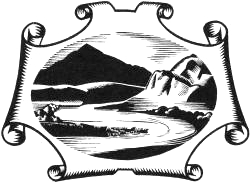 |
From earliest time the
valley of the Rio Grande has been a natural pathway for men
traversing the Southwest. It was an ancient trail before
Europeans set foot on the Western World; and when the
Spanish in their widening conquests advanced up the central
plateau of Mexico, they found the river course the easiest
route into the unknown North.
Where the Rio Grande issued from the southernmost spurs of
the Rocky Mountains, its valley narrowed sharply through a
Pass, immediately recognized by the Spanish as of great
strategic value, their doorway to the North. They named this
place El Paso del Norte. |
| For almost four
centuries history has been made by the procession of strong
men who have filed through that pass. This book holds the
portraits of twelve such men. Various not only in character
but in accomplishment, these early travelers through the
Pass each unfold a picturesque legend of the land. Their
portraits might each be considered as characteristic symbols
of early chapters in the history of the West, episodes in
the conquest of that Pass of the North where a modern city
now stands.
- Tom Lea |
|
|
|
|
|
|
|
THE WANDERER
1536
Alvar Nuñez Cabeza de Vaca
The annals of exploration hold no more dauntless wanderers
than Alvar Nuñez Cabeza de Vaca and his three companions,
Castillo, Dorantes, and the Moorish slave Estéban. Survivors
of the ill-fated Narváez expedition of 1528, they were cast
from a raft upon the shores of East Texas in a storm, bereft
of their weapons, supplies, even their clothes. Captured
naked by Indians and held as slaves, they endured years of
captivity before they were able to escape together and set
out to find their own people. Clad like savages, these
intrepid men walked from the East Coast of Texas hundreds of
leagues over desert and mountain to the town of Culiacán
near the West Coast of Mexico. First white men to cross the
North American continent, their route led them over the Rio
Grande close by the Pass of the North. With their crude
Cross and Christian prayers they were welcomed as healers by
friendly tribes who guided and fed them along the way. Eight
toilsome years after the wreck of the Narváez expedition,
they found their way back to the realm of Spain, bringing
the first accounts of the buffalo and the vast, unknown
wilderness to the north. |
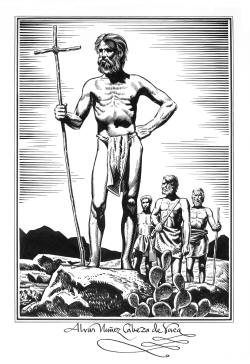 |
|
|
|
THE MISSIONARY
1581
Fray Agustín Rodríguez
First of the Spanish expeditions to use El Paso del Norte in
following the course of the Rio Grande northward was a small
party led by the Franciscan friar Agustín Rodríguez. In the
summer of the year 1581 it passed this way. The Spanish had
not penetrated north of the Chihuahua mines since the
failure of the Coronado expedition in 1540, and Rodríguez
was the first in forty years to obtain a viceroy's consent
to a northern journey. Accompanied by two zealous Franciscan
brothers and an escort of nine soldiers headed by Captain
Francisco Chamuscado, Rodríguez set out on June 5, 1581,
following the course of the Rio Grande to Taos, exploring
eastward to the buffalo plains, and west to the Zuñi
villages. In February,
1582, when Chamuscado and his men turned south for a return
to Mexico, the Franciscans remained at a pueblo near the
present town of Bernalillo, to begin a conversion of the
natives. Within a few months they were murdered by the
Indians. Captain Chamuscado died on the march to Mexico
City, and the only account of the expedition was rendered by
two of his soldiers, Hernán Gallegos and Pedro Bustamente. |
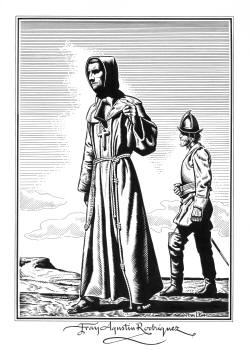 |
|
|
|
THE EXPLORER
1582
Don Antonio de Espejo
The entry of Espejo and his men, through the Pass of the
North, into the Pueblo Indian country is one of the brighter
chapters in Spanish exploration of the Southwest. Receiving
permission to lead an expedition to the relief of the
missionaries of the Rodriquez party, Espejo set out
northward from San Bartolomé, Chihuahua, in November, 1582,
in command of sixteen men. Tracing the route of the three
friars, he soon learned of their deaths the previous year.
An energetic leader, Espejo further carried out a most
remarkable and successful exploration of the entire Pueblo
area, from far past the Hopi villages in the West to the
buffalo ranges east of the Pecos River, which he named Rio
de las Vacas and followed southward to its confluence with
the Rio Grande on his return to Mexico. His party
arrived at San Bartolomé in September, 1583, without the
loss of a single life, and without antagonizing the natives
of a single province. His account of his journey led
directly to the later colonization of New Mexico, and his
conduct of the expedition reveals a superior leader, at once
enterprising, courageous and intelligent. |
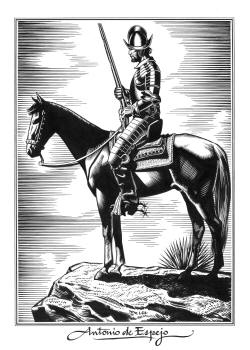 |
|
|
|
|
THE VISIONARY
1591
Gaspar Castaño de Sosa
The rich Lieutenant Governor of the province of Nuevo
León, Don Gaspar Castaño de Sosa had long wished to lead an
expedition of colonists into the promising lands north of
the Rio Grande. At length, in 1590 he was able to organize
under his command about one hundred and seventy persons and,
accompanied by ox carts laden with supplies, set out for the
North—but unwisely without consulting the viceroy or
obtaining authority of the king in any way. Following the
course of the Pecos River north to its source, the
expedition penetrated into the Pueblo country of New Mexico
and visited most of the native settlements of the Rio Grande
region. Indian troubles and an attempted rebellion among
subordinates led to a decision to return to Mexico. In the spring of 1591 the
expedition headed south along the Rio Grande, where it met
with the Viceroy's Captain Juan Morlete, come to arrest
Castaño de Sosa for entering the country without a license.
The party continued its march southward through El Paso del
Norte, and returned to Mexico with its leader, Don Gaspar,
in chains. |
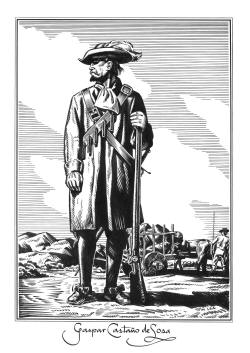 |
|
|
|
CONQUISTADOR
1598
Juan de Oñate
The successful colonization of New Mexico was accomplished
by Don Juan de Oñate. A royal contract for the settlement of
a new province was granted him only after long delays and
sharply contested negotiations with the authorities of the
Indies; but at length, in January, 1598, properly
accredited, Oñate set out from the mines of Santa Barbara,
accompanied by a large force of soldiers, colonists with
their families, herds of livestock, and a long line of
ox-carts laden with supplies. After traversing the State of
Chihuahua, the expedition crossed the Rio Grande about
twenty-five miles south of El Paso del Norte, where
elaborate ceremonies were held on taking possession of the
new lands. Proceeding to the Pueblo
region up the Rio Grande, Oñate conquered the native tribes
and planted a mission and settlement at San Juan de los
Caballeros on the Chama. After numerous exploring
expeditions east and west, a few years later he permanently
established his colony at Santa Fe. The work of Oñate
fittingly closed a century of exploration and attempted
settlement, and opened a new century of colonization and
expansion by laying the cornerstone of Spanish occupation
north of El Paso. |
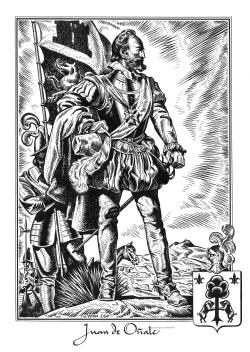 |
|
|
|
THE BUILDER
1659
Fray García de San Francisco
The first building at El Paso del Norte was the temporary
mission structure built by the Mansos Indian converts of
Fray García de San Francisco y Zuñiga in the year 1659. Fray
García saw clearly the importance of a permanent mission
establishment at the gateway to the northern Spanish
provinces. Nine years later through his strenuous labors and
wisdom with the Indians, he completed the mission building
still standing today in Ciudad Juárez and dedicated to
Nuestra Señora de Guadalupe. By the time his church was
completed in 1668 Fray García's settlement could boast of
many thousands of head of livestock, extensive irrigated
fields and the beginnings of orchards and vineyards. Fray Garcia
labored for twelve years at the Pass, and died in 1673 at
the convent of Senecú. His life-work received high
commendation from the chroniclers of his times; and his
wisdom in the choice of a mission site was proved in 1680
when the frontier mission settlement he founded became the
rallying point of the destitute Spanish colonists driven
from New Mexico by the revolt of the Pueblo Indians. |
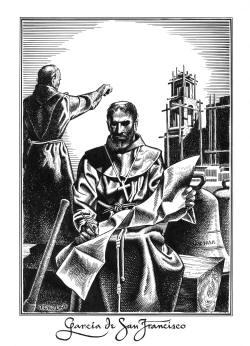 |
|
|
|
THE WARRIOR
1692
Don Diego de Vargas
When the Pueblo Indians revolted against Spanish rule in New
Mexico over four hundred Spaniards were slain, and the
remaining colonists, numbering almost two thousand, were
forced to evacuate their settlements and flee the country.
They came to El Paso del Norte in 1680, taking refuge on the
south side of the Rio Grande at the mission established a
few years earlier by Fray García de San Francisco. Here they
lived for more than a decade, building several new missions
in the vicinity—including those at Socorro and Ysleta —and
developing the river lands, while military expeditions used
the Pass as a base of operations in unsuccessful attempts to
reconquer the lost provinces to the north. It was not until
1692 that a successful entrada and reconquest was affected,
under the new leadership of Don Diego de Vargas, a soldier
of energy and talent. With a force of less than three
hundred men he marched rapidly up the valley of the Rio
Grande, took Santa Fé, and eventually won the complete
submission of the rebellious Pueblos. The war waged by
Vargas permanently broke the forces of native rebellion and
left the province quiet for a subsequent one hundred and
twenty-two years of Spanish rule. |
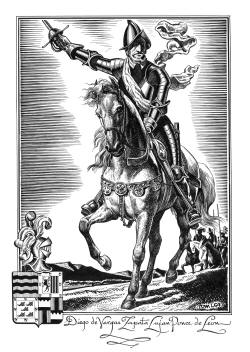 |
|
|
|
THE PRECURSOR
1807
Zebulon Pike
When the United States acquired the Louisiana territory its
vastness was unmapped. In the summer of 1806 a young Army
officer named Zebulon Pike received orders to explore and
chart the remote line between American territory and
Northern Mexico. Pike proceeded to march 800 miles across
the plains to the Rocky Mountains and lead his party through
the broken canyons of the Sangre de Cristo range in the dead
of winter. Then to rest his half-starved and half-frozen
men, he made a stockaded camp near the Red River inside
Spanish territory—where he was discovered by a superior
Spanish force, made prisoner, and marched to Santa Fé,
accused as a spy. Pike was escorted from Santa Fé to
Chihuahua, and held in Mexico for several months before his
release. With an
intelligence to match his intrepidity he kept a concisely
accurate daily account of his journey, which was published
on his return to the United States and remains today one of
the best narratives of early western travel, This Journal,
and the peak he discovered in Colorado, perpetuate his name;
and through his enforced trip down the Rio Grande as a
captive in 1807, Zebulon Pike became the first American
citizen of record to enter the Pass of the North. |
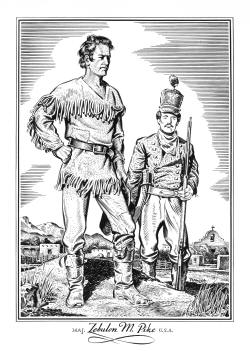 |
|
|
|
THE SETTLER
1827
Juan María Ponce de Leon
For a century and a half the frontier settlement Paso del
Norte remained on the south side of the Rio Grande. A new
phase of the settlement's growth began when Juan María Ponce
de Leon, a prominent resident at the Pass, applied to the
Chihuahua government for a grant of land on the north bank
of the river opposite his town. In September of 1827, upon
the payment of a sum equivalent to eighty dollars, Ponce
received title to about 500 acres and began developing a
rancho on the new grant. The home he built there was the
first building on the future site of the city of El Paso. He
cleared and leveled rich bottom land by the river, and
channeled irrigation ditches through it. Beans, chile, corn
and wheat grew in his tree-lined fields, and his vineyards
prospered. Around the ranch
he built walls to protect his flocks from wolves, and at the
corners of his fields he built round watch towers to guard
his establishment against Apache raids. Ponce's wealth and
influence grew; he became jefe politico, and commander of
units of Chihuahua militia. Defending the Pass with this
militia in 1846, his force was defeated at the Battle of
Brazito. Ponce retained title to his ranch after it became
American territory, and died there in 1852. |
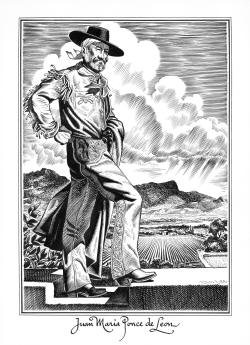 |
|
|
|
THE TRADER
1848
James Magoffin
The Mexicans called him Don Santiago; his American friends
knew him as James Magoffin, the most genial, energetic and
successful of the early traders who braved the trail through
the Pass of the North. As a young man he cast his fortune
far west of the frontier of his native Kentucky: he
freighted caravans of goods across the Great Plains and into
northern Mexico as early as 1828. James Magoffin grew fond
of the Southwest, became well and favorably known to its
people, and married Mary Gertrude Valdéz. The United States
government made him the first American consul to the State
of Chihuahua; and when war with Mexico came, it was
Magoffin, working as an American agent, who "persuaded"
General Manuel Armijo to surrender New Mexico without firing
a shot in its defense. In 1848,
Magoffin founded a trading post at the Pass. He built its
adobe walls around a large open square; there he conducted
his business and dispensed a hospitality that made him
famous to travelers across all the hard and thirsty miles of
the desert Southwest. Magoffinsville became a nucleus of the
future city of El Paso. The house of James Magoffin still
stands under its big trees, a sturdy reminder of days when
it was a fortress of refuge and a pleasant oasis in a wild
and empty land. |
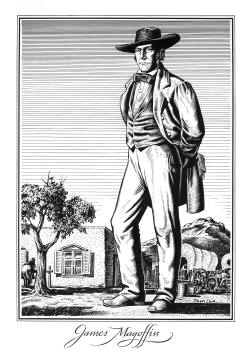 |
|
|
|
THE SOLDIER
1846
Alexander Doniphan
When war broke with Mexico in 1846, Alexander Doniphan was a
young lawyer of Western Missouri. At war's end, he was the
famed commander of one of the great marches in military
annals. Enlisting as a private in the First Missouri Mounted
Volunteers, he was elected Colonel by the men of the
regiment, and his force became a part of Kearny's "Army of
the West" that took New Mexico in a bloodless coup. Then,
after a hard campaign in the Navajo country, Doniphan's
regiment was detached to march south for a junction with
General Wool's forces in Chihuahua. Wool never got there:
Doniphan's undisciplined, unsupplied, unpaid and unassisted
volunteers secured north central Mexico alone, and
ultimately joined Wool and Taylor near Monterey. Living off the
country like frontiersmen, these natural fighting men forced
their marches through more than a thousand miles of hostile
desert—and twice met and routed superior forces in battle.
One of these engagements was fought on Christmas afternoon,
1846, at Brazito, on the Rio Grande forty miles above El
Paso. Two days later Doniphan and his men brought the
sovereign flag of the United States through the Pass of the
North for the first time. |
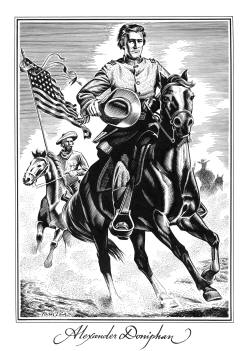 |
|
|
|
FRONTIERSMAN
1850
Big Foot Wallace
A nineteen year old boy from Virginia, William A. A.
Wallace, came to Texas to avenge his brother Sam's death at
Goliad. Though he arrived in 1837, too late to participate
in the Texas War of Independence, he fought Mexicans and
Indians with immense gusto through all the frontier decades
of Texas history. As a Texas Ranger, as a soldier in the
Mexican War (he got his Big Foot nickname as a prisoner in
Mexico City where no sandals were big enough to fit him) and
as a lone hunter, he packed his long life with hardship and
high adventure. A giant in strength and stature, with eye
and trigger ringer sharp as his courage, Big Foot became the
very embodiment of the frontiersman who lived rollicking in
danger, warming his heart with the wilderness. When settlements
began to confine him in his familiar ranges, in 1850 he
contracted to carry the mail on the first stage line from
San Antonio out across the trans-Pecos wastelands to El
Paso. He made the trip to the Pass of the North once a month
for several years, fighting off Indians, whipping up the
mules, telling stories like Odysseus, and consulting his
jug. Wallace lived long past the times he loved; he died in
1899 in a nearly civilized Texas. His grave is in Austin,
but no tombstone can ever imprison the frontier legend of
Big Foot. |
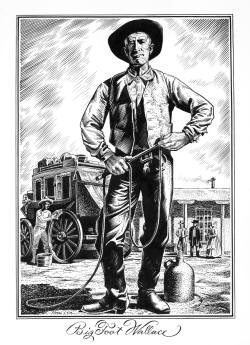 |
|
|
B I
B L I O G R A P H Y |
| Magoffin |
| Bartlett, John Russell.;
Bieber, Ralph P. editor. Personal Narrative of
Explorations and Incidents in Texas, New Mexico, California,
Sonora and Chihuahua, volume 1. New York, D. Appleton &
Co., 1854. |
| Ponce
|
| Exploring Southwestern
Trails: The journals of Lieut. W. H. C. Whiting (1849).
Glendale, Cal., Arthur H. Clark, 1938. (Southwestern
Historical Series v.7). |
| Rodriguez,
Espejo, Sosa, Oñate, Vargas |
| Bolton, Herbert E., Editor.
Spanish Exploration in the Southwest, 1542-1706. New York,
Charles Scribner's Sons, 1925. (Original narratives of early
American history) |
| Doniphan,
Magoffin, Ponce |
| Connelley, William E.; Couse,
Elliott, Editor. Doniphan's Expedition and the Conquest
of New Mexico and California; includes a reprint of the work
of Col. John T. Hughes. Kansas City, Bryant & Douglas
Book and Stationery Co., 1907. |
| Pike |
| The Expedition of Zebulon
Montgomery Pike to headwaters of the Mississippi River,
through Louisiana Territory, and in New Spain, during the
years 1805-6-7, to headwaters of the Mississippi River,
through Louisiana Territory, and in New Spain, during the
years 1805-6-7. New York, Francis P. Harper, 1895. |
| Wallace |
| Duval, John C. The
Adventures of Big Foot Wallace. Austin, Texas, J. W.
Burke & Co., 1870. Reprint Austin, Steck Co., 1935. |
| Doniphan,
Ponce |
| Gibson, George Rutledge.
Journal of a Soldier under Kearney and Doniphan, 1846—1847.
Edited by Ralph P. Bieber. Glendale, Cal., Arthur H.
Clark, 1934. (Southwestern Historical Series v.3). |
| Cabeza de
Vaca |
| Hodge, Frederick W., Editor.
Spanish Explorers in the Southwestern United States,
1528-1543. The Narrative of Alvar Nuñez Cabeza de Vaca.
New York, Charles Scribner's Sons, 1907. |
| Garcia |
| Hughes, Anne E. The
Beginnings of Spanish Settlements in the El Paso District.
Berkeley, University of California Press, 1914. Reprint, El
Paso, Texas, El Paso Public Schools, 1935. |
| Rodriguez,
Espejo |
| Luxan, Diego Perez de.
Expedition into New Mexico Made by Antonio de Espejo,
1582.—1583, as revealed in the journal of Diego Perez de
Luxan, a member of the party; translation, with introduction
and notes by George P. Hammond and Agapito Rey. Los
Angeles, Quivira Society, 1927. |
| Wallace |
| Raht, Carlysle Graham.
The Romance of Davis Mountains and Big Bend Country El Paso.
The Rahtbooks Company, 1919. |
| General
Reference |
| Twitchell, Ralph E.
Leading Facts of New Mexican History. Cedar Rapids,
Iowa, Torch Press, 1911-1911. |
| Oñate |
| Villagra, Gaspar Perez de.
History of New Mexico, Alcalá, 1610. Translated by
Gilberto Espinosa; introduction and notes by F. W. Hodge.
Los Angeles, Quivira Society, 1933. |
|
|
|
|
Photo-offset reproductions
from the original large folio
1946 limited edition designed
and printed by Carl Hertzog.
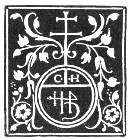
El Paso, Texas,
1947 |
|
